Slatwall has come a long way.
If you still think of slat wall as the old, battered, flat-gray slat wall that you see in old retail stores like Sears, then let’s get you up to date.
Slat wall is now become more and more common in garages, as well as stores. Because homeowners want a little more style, you can now get slatwall in various colors, materials and even custom designs.

One other note: In some parts of the country, it’s more common to refer to this as slot wall (with an ‘o’). This is just a different way of referring to the same thing. Since I’ve always heard it called ‘slat wall’, that’s how I’m going to call it in this article.
Buyer’s Guide
Slatwall is among the most popular ways to organize your tools and equipment in a garage. These panels with horizontal grooves can help you drastically save space while also improving the overall organization. They aren’t that difficult to install, and once you do it, you will see for yourself how much easier these things can make your life.
wall covering as well as storage…..
Slatwall is great for storing anything from your garments or your sporting equipment to the tools and machines for your garage workshop. They are practical in so many ways and are also known to be very durable.
Reasons to Get a Slatwall System
There are several really great reasons to invest in a slatwall system for your garage, which makes sense given it’s popularity.
Here are some of the reasons you need to install one in your garage:
Versatility
I come from a retail background, so I’ve been using slatwall for decades in some fashion. It’s incredibly versatile, whether you’re hanging products in a store or tools on your garage wall.
Most other storage solutions have a fixed layout, which means you’re locked into one configuration. If you add a new tool, you’ve got to make it fit in the existing layout.
But with slatwall, you’ve got a much larger area to work with and an infinite number of ways you can do it.
I have a small section of Gladiator GearWall in my garage for my lawn tools. Trust me, once you have slatwall installed, you’ll wonder how you ever were organized anything before.
More free space
Another very important reason to get a slatwall for your garage is that it will help you save a lot of space. Not only are things much more accessible and organized when they’re up on a slatwall instead of just lying around, but this will also help you save precious floor space in your garage.
And this may actually also be beneficial for the car. With more space around it, it is less prone to getting scratches. If you park your car outside because your garage is too cluttered, this might actually let you take your car indoors.
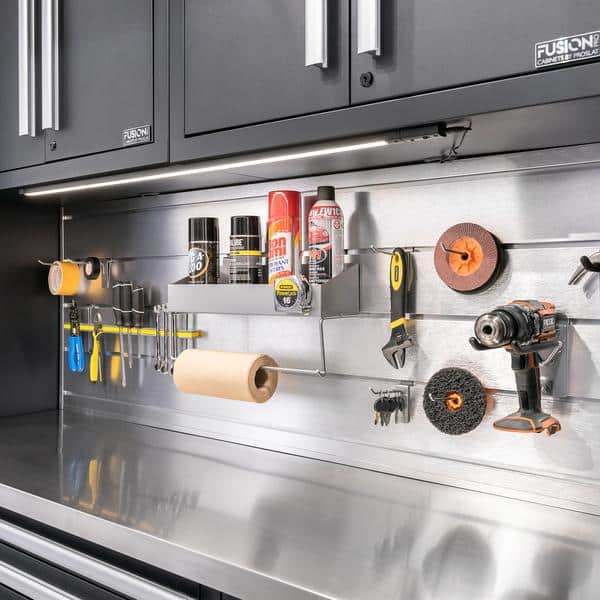
It Looks Great
Admittedly, this comes down to personal preference. You’ll find most people solidly prefer either slatwall or pegboard. However, there’s no denying that both look much better than any DIY wall storage system.
Many high-end garages will cover an entire wall in slatwall so there’s a cohesive look, while still giving the maximum flexibility for storage. You can get slatwall in several different colors and styles, including brushed aluminum to give your garage an upscale look.
Durability
Slatwall is designed to take a beating, which makes sense given it’s background in retail stores.
Most garage slat walls are made of either Polyvinyl Chloride (PVC), steel reinforced wood, or aluminum. They’re going to last a very long time and have a very high weight capacity compared to other garage storage solutions.
How much can slatwall hold? The major residential slatwall manufacturers (Flow Wall, Proslat and Suncast) each say their slatwall systems can hold up to 100 lbs. per square foot.
For a 4′ x 8′ section, that’s up to 2400 lbs. of storage capacity, which is just insane!
Slat Walls vs. Pegboards: Which to Choose?
Most people are quick to jump in on one side of the other on this discussion. However, both slatwall and pegboard have their place in your garage. In fact, my garage uses both a slatwall-type system and pegboard.
In general, slat wall will have a higher weight capacity than pegboard. You’ll be able to hang large tools and heavy-duty shelves from slatwall that would rip the pegboard right out of the wall.
Slatwall also looks more “finished” than pegboard does. Many people’s perception of pegboard is the old, brown MDF boards that our dads had in their garages. It’s come a long way since then, but that first impression stuck with us.
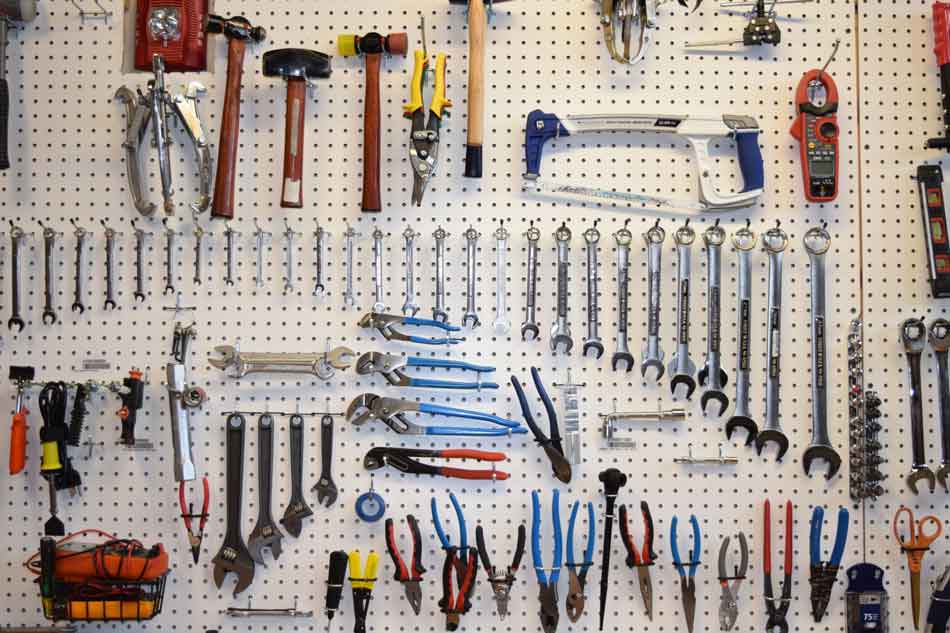
Pegboard is amazing for storing lots of smaller tools on a single panel that won’t take up that much space. If you want to keep your wrenches and screwdrivers while displaying them for everyone to see, then pegboard is the obvious choice.
As I mentioned, I have both pegboard and slatwall in my garage. I use pegboard above my garage workbench while letting the slatwall do the heavy lifting organizing my lawn tools.
It all comes down to how you want to organize your tools.
How Is Slatwall Different Than a Track System?
While we’re making comparisons, I want to say a few quick words about wall storage systems like Gladiator GearTrack or Rubbermaid FastTrack.
Those systems are a great, inexpensive way to store your tools like you would with slatwall, but they’re not the same thing.
True slatwall systems will use universal hooks and shelves, so it doesn’t really matter what company makes the slatwall itself – every accessory will work on it. That can’t be said for the wall storage systems. Even though they use a similar concept, standard slatwall hooks are not compatible with them.
That’s not to say that these systems aren’t great solutions. I use both the Gladiator GearTrack / GearWall and the Rubbermaid FastTrack in my home. If you want to find out what I think of them, click on either link for my detailed review.
Are All Slat Walls The Same? (Things to Look For)
Just because slat wall is universal doesn’t mean that it’s all built the same.
There are many different companies that make slatwall and each has their own manufacturing process. The overwhelming majority of those companies are making slatwall for a retail store, so you may have to do some digging to find slat wall that’s right for your garage.
So what are the things you need to look for in a good garage slatwall system?
Metal Inserts = Higher Weight Capacity
One of the big reasons to invest in slat wall is because of the higher weight capacity. But without metal inserts in your slatwall, you won’t be able to hang as much as you might think.

Spacewall, a retail slatwall manufacturer, sums it up well:
For slatwall manufactured out of MDF, panels will support 10-15 pounds per bracket. Reinforced slatwall with metal inserts supports 50-60 pounds per bracket.
That’s a huge difference in overall weight capacity!
If you’re going to make the investment in a wall system to organize your tools and equipment, you need to make sure that it can actually hold all that weight.
Better Materials = Better Durability
If you’ve ever gone to an older retail store, you’ve probably seen some older slat wall panels have taken a lot of abuse. Your garage probably won’t beat them up to that extent, but you still want to make sure that your slatwall will last.
Modern slat wall is available in several different materials. These range from Medium Density Fibreboard (MDF), which is the cheapest, all the way up to brushed aluminum. Some other common materials are wood and PVC plastic.
Although it’s tempting to go straight to the brushed aluminum (because it looks amazing!), just be aware that they’re considerably more expensive than wood or plastic slat wall panels.
Appearance Matters
Speaking of looking amazing, you can get slat wall in a bunch of different colors, styles and finishes, and even one that’s an American Flag.
I admit, this is probably the last thing should factor into your decision. However, if you’re looking for a way to add some style or color to your garage, you might want to think about it.
Accessory Support
The beauty of slat wall is that if you find a hook or accessory that you like, it’s almost always going to work on your slatwall, no matter who made it.
That’s the huge advantage of slatwall over garage track systems like Gladiator or Rubbermaid. Because their hooks are proprietary, you’re locked into their system. If you see that a slat wall manufacturer has “proprietary accessory design” (or something similar) that should be a huge red flag for you.
With hundreds of different accessories to choose from, it’s easy to find something that will work for your garage.
Easy to Install?
Most slatwall systems will just screw into wall studs or concrete. A few will come with features that make it easier to install.
If you get a system that’s easy to install, you will not have to pay a professional to help set up the system for you. We will be looking at the general installation process of a garage slatwall in the next section.
Price
One last thing that is worth considering before investing in a garage slatwall is that they are more expensive than other wall systems like pegboards or wooden walls.
That said, you’re getting a superior output in terms of aesthetics, versatility, and durability. To put it shortly, slat walls are a good long term investment.
How to Install a Garage Slatwall
At this point, it’s worth looking briefly at how to install garage slatwall at home.
Most people will opt to hire a pro for this, just because it’s a long, involved process. Also, let’s face it: slatwall is heavy.
But if you’re the DIY type, this is definitely a doable project for your next free weekend. Just follow the steps below:
- The first step is to find out what the lowest point of your garage ceiling is. Choose a point in the room and draw a level line that passes through it. Now measure the height from this line to the ceiling at each point. After this, locate and mark the point where the height is the smallest.
- Once you have located the lowest point of the ceiling, draw a line about a foot below this point. This will be the top of your slatwall installation.
- Find and mark the wall studs. Wall studs are the inner vertical frames supporting your garage’s structure. If you install your slatwall by attaching it to the studs, it will have more support later.
- Install J-Tracks at the end of each slatwall panel. Then take one of the panels and place it horizontal to the line you drew about a foot below the lowest point of the ceiling. Now drill a screw at each point along the stud line.
- Take the second panel and align it to the bottom of the first panel. The panels have a tongue-and-groove system that attaches each panel to the one above it. Once attached, drill a screw at each point along the stud line.
- Repeat step 5 for all the panels. You will soon have a fully installed slatwall.
Be sure to use screws that are long enough to penetrate deep (at least an inch) into the stud. This secures the slat wall to the stud so it doesn’t come loose when you hang something heavy on it.
Must-Have Garage Slatwall Accessories
One of the biggest advantages of slat wall systems is the literally thousands of accessories that are available.
Let’s take a look at some of those now:
Peghooks
Ahh…peghooks. This really takes me back to my retail days.
Peghooks are available in so many different types, lengths and shapes. They’re probably the accessory you’re going to use most on your garage slatwall.
Single hooks are the most common of all slatwall accessories. They’re a simple hook on a backing piece that can move around as you need them to. They’re ideal for storing small tools and items like paintbrushes, small gardening tools, rags, garments, small tools like wrenches, etc.
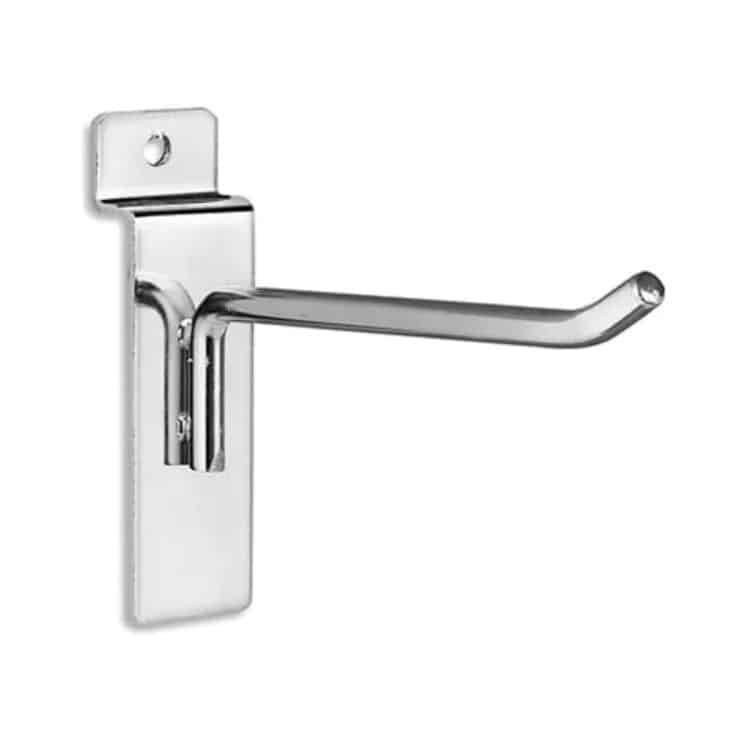
Double peghooks are simply two single peghooks into joined together. They’re considerably stronger when compared to single hooks and are capable of supporting heavier tools and equipment like shovels, rakes, baseball bats, etc.
Taking that a step further, deep utility hooks are the strongest of the three types and is capable of storing anything from hoses and small ladders to folding chairs. For most garages, this should suffice.
You can find an assorted pack of peghooks in various shapes and sizes on Amazon for around $25.
Specialty Slat Wall Hooks
Specialty hooks are hooks that are specifically designed to hold heavy equipment such as kayaks, vehicle tires, big ladders, lumber, etc. These hooks are usually over 25 inches (63.5cm) and can be really helpful in saving up a lot of space in your garage.
Garment Hooks
Remember that most slatwall is designed for retail stores, so a garment slatwall hook is designed to hold one piece of clothing on a coat-hanger for display.
The ends of the hooks have a large cap on them designed to keep the hanger in place. They can be used to hang anything from your jackets to your raincoats.
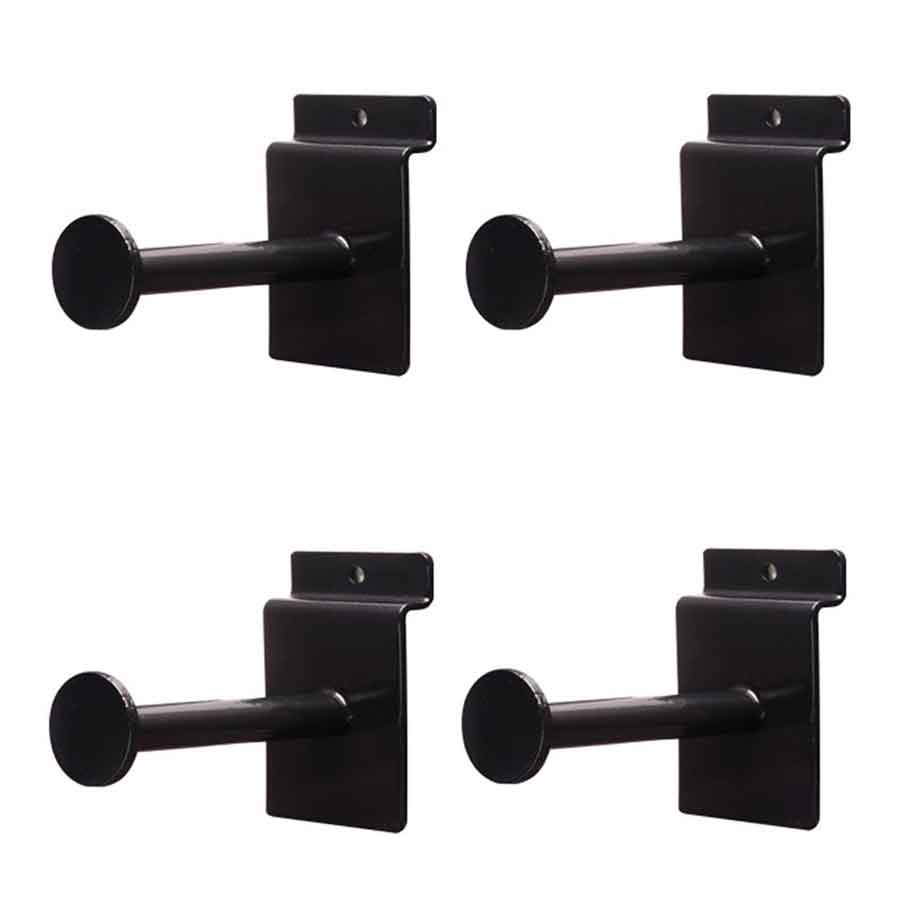
Most people use them to store their motorcycle helmets and gloves as well. You can find these in in various sizes and lengths for around $35 on Amazon.
Baskets
Baskets are one of the most useful accessories you could install in your garage slatwall. They are literally baskets with a a bracket that let’s them hook on to your slatwall.
You can use them to store pretty much anything from garments, sporting equipment, aerosol cans to helmets, shoes, etc.
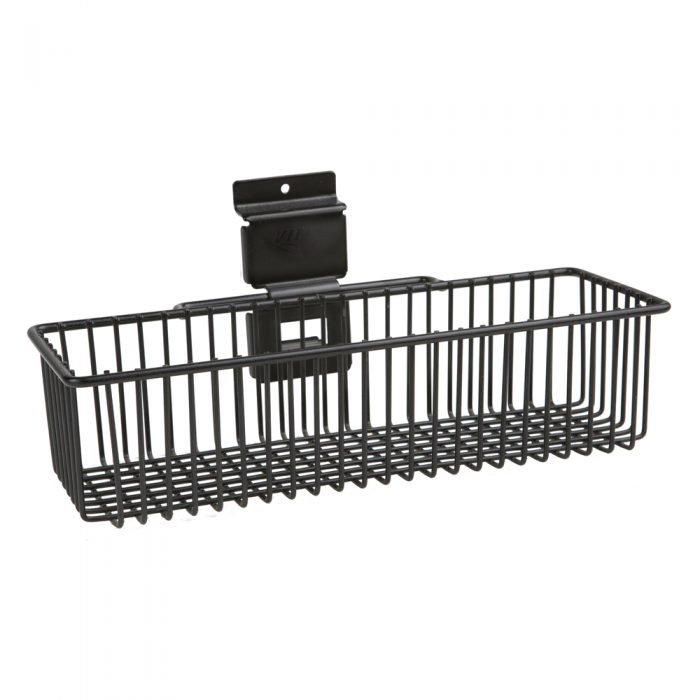
Viper tool storage makes a great slatwall basket in several different sizes.
Toolbars or Holders
Depending on where you install your slatwall, you might want easy access to your more important tools. Toolbars can help you keep your tools organized and available for easy access.
Magnetic toolbars are special versions that use magnets to hold small tools in place.

A screwdriver holder is probably my favorite accessory that you can add to your slatwall. It’s a simple magnetic panel that’s used to hold all the screwdrivers.
They’re very inexpensive on Amazon and are well worth the price.
Bike Hooks
I’m not an avid biker by any means, but it’s incredibly popular in my neighborhood. The thing about bikers is that they all need somewhere to store their bikes.
Bike hooks fit that need. They let you hang your bike up on the slatwall, leaving more space in your garage.
Vertical bike hooks keep bicycles perpendicular to the wall, with the tires pointing toward the ceiling. Horizontal bike hooks, on the other hand, keep them parallel to the wall.
Bike hooks not only help you save space but also help keep your bike from getting damaged from tipping over or getting hit by your car.
Shelves
Unfortunately, not every item in your garage can be stored in hooks or baskets. That’s where shelves come in.
Shelves are a must-have accessory for any garage slatwall. If you detail your car, they’re the perfect solution for storing your cleaning supplies that can’t be hung on a hook or thrown into a basket.
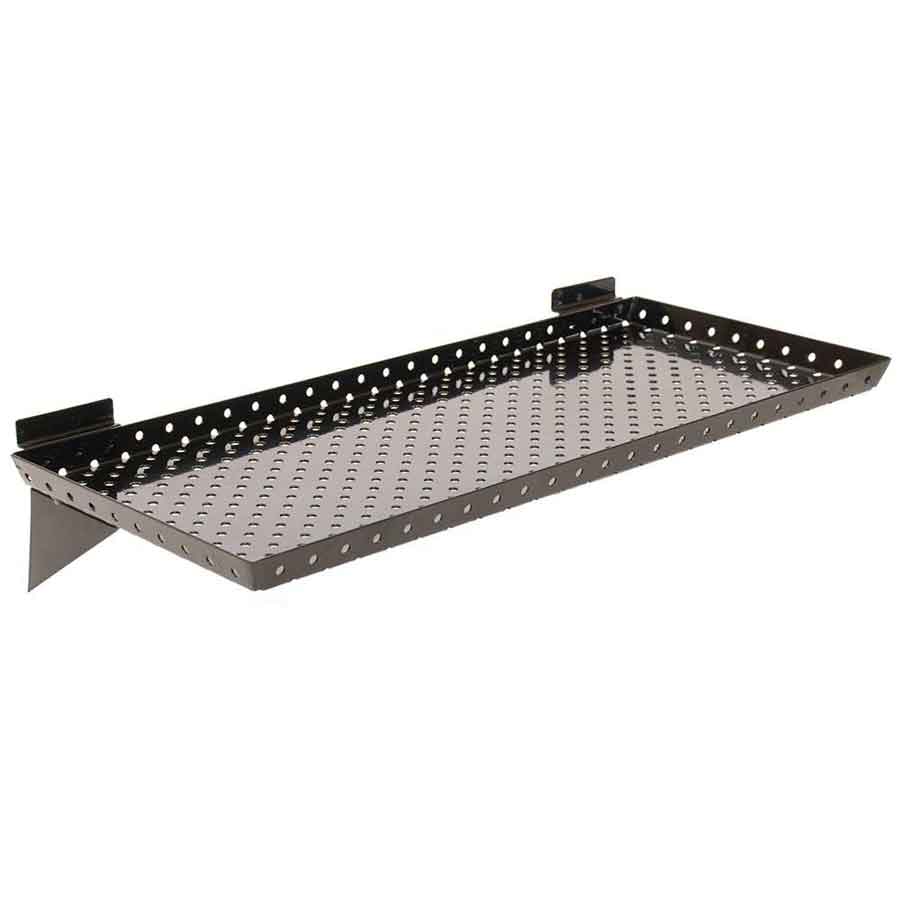
There are plenty of shelves designed for garage slat walls. Some are specifically designed with slots for cans and bottles. Others are perforated, ideal for storing your boots and shoes, like this one from KC Store Fixtures.
Tilt-Out Storage Bins
A tilt-out storage bin is another great accessory for any garage/workshop slatwall. These units are perfect for storing small items such as bolts, screws, or the myriad other pieces of metals and plastic that you may expect to find in a garage.
Are Slatwall Accessories Interchangeable?
For the most part, slatwall accessories are all interchangable. There are a couple of notable exceptions, however. Gladiator GearWall accessories are proprietary and won’t work with any other system.
In the vast majority of cases, if something is advertised as a ‘slat wall accessory’, it’ll work no matter who made your slatwall panels.
Conclusion
Slat walls are one of the most popular garage wall systems. They make storage and organization much easier for you while improving the look of your garage.
If you have a cluttered garage that you want to organize, you might want to consider investing in a good slatwall system. They are versatile and durable wall organizational systems and can make your life much easier.
The post Slatwall Isn’t All The Same: Buyer’s Guide to Slat Wall Systems appeared first on Garage Transformed.
